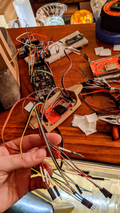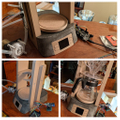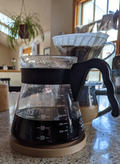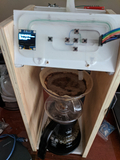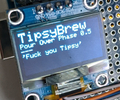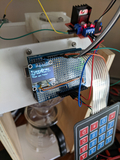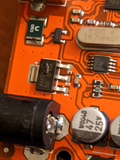TipsyBrew now comes in Matte Black! See picture of the preproduction unit in Matte Black in a very dark room below! Full disclosure: This post was written out of spite.
Keep Reading →
In the video above you can see a breadboard prototype of the ESP32 MkII Pour Over Robot starting up. First you can see the start up screen. While this is loading, wifi is also connecting. When the wifi becomes active you can see the wifi symbol appear in the upper right hand corner. NTP sets the time which is top center. It is sort of a bug that it shows 7:00 before the time sync occurs. MkII…
Keep Reading →
I'm going to try and make this quick. Not because I don't think code isn't important, but because I think your time is more worthwhile spent reading the actual code, because it is FAR more interesting than me talking about it. I will mention a few things here, but I encourage you to head to GitHub to check things out. So the first thing I want to mention is that I am currently using an ESP32 and…
Keep Reading →
User Interface Work The current TipsyBrew POR mkII user interface is an ILI9341 LCD display with two buttons to each side. The LCD is 2.2 inches and lacks a touchscreen, hence the buttons. I realize when I write statements like the previous one that this information seems incredibly obvious to me because I am working on it constantly. However, you may be reading this thinking, "How long have you…
Keep Reading →
So my wire usage has exploded because last night for some reason I thought, "Hey, everybody keeps saying that the LCD screen I am using is 3.3v logic only. I should stop using 5v." Now I will say that everything was working great. The screen shows no issue, the SD card is good, nothing is wrong. I fully accept that "everything still works" is not proof that I am doing it right. So I grabbed some…
Keep Reading →
I keep walking away from completing this post in favor of doing work on TipsyBrew. So I am going to pick up the pace and write this as quick as possible. Hopefully, once you see what I have been working on, you will understand why I am so excited. The Stand is Being Worked From the Bottom Up If you have been following me ANYWHERE, you have been seeing some concrete progress on the mkII stand. I…
Keep Reading →
Mark II of TipsyBrew has a few goals in mind and also I have been listening to the community for what they would like to see in mkII. With this in mind I have been ordering more parts, experimenting with new methods and materials, and making updated designs. If you have been following along with TipsyBrew's other outlets (Twitter, Discord, YouTube), you may have a bit of an idea of what I am…
Keep Reading →
You may have noticed a recent slowdown in TipsyBrew updates. This is (mostly) due to the dreaded summer responsibilities (sigh, adulting). I'm not going to sugarcoat this one bit. I love TipsyBrew and the current rig has been dutifully making me coffee on a daily basis without issue. However, this is an mostly unfunded project (except for a few cups of coffee thrown this way by my excellent…
Keep Reading →
Without further ado, I just pushed some code to GitHub. Admittedly, the code is a bit of a mess but it works. I have been struggling with getting the servo arm to draw circles well. I believe my math is good (look for a math lesson soon) but they keep coming out as wide ovals in the real world. I believe that the reason may be because the angle servo moves completely then the distance servo moves…
Keep Reading →
Last time we talked, I told you that the spoon water spreader was good, but not great. I was really seeing the value in moving the pour spout around a bit. So, that is what I did. Cue the footage of me moving the hose around with my hand... We don't have that footage?... It was crap?... Pfff, good help is hard to come by these quarantine days. I guess we can just skip ahead to the better solution…
Keep Reading →
First off, what you see above is the end of a fantastic bag of beans that was my bounty from winning the infamous bet. TipsyBrew made some amazing coffee out of those beans. They will be missed and I thank my friend for honoring the bet in such delicious fashion. I am in no way disappointed by the coffee that comes out of the TipsyBrew, but I do think I can do better. Let's take a look at what I…
Keep Reading →
Control Panel Experiment I know this isn't pretty, but remember it was a 4x4 membrane keypad with the OLED taped to it just flopping around. As you may have noticed the arduino isn't up front anymore. My original thought was to stack a shield or two over the arduino, but there are just too many things that won't fit on a shield, like motor controllers and buck converters. So I made the choice to…
Keep Reading →
All we need here is an arduino, 12v power, 12v DC motor, and of course an L298N driver. I won't into the technical intricacies of the L298N, but it has some really useful features for not much money that is great for TipsyBrew. First off, if you haven't been keeping tabs on the project, I am using the arduino MEGA 2560 full time now because the OLED requires too much memory for the UNO to be…
Keep Reading →
Use It The first cup of coffee was actually quite the jump of functionality. If you are just a casual follower or you are just joining the journey of TipsyBrew Pour Over, you may not understand what is going on at all. I think the best place to start is going through how it is used. Behind the stand is an electric kettle. Before the video started I filled the kettle, ran it to a boil, then rinsed…
Keep Reading →
More details to come, but definitely head over to discord if you have any questions. Clearly I have some improvements to make, but FIRST CUP!!!!
Keep Reading →
I have to admit that in the great rush to beat that other project to a cup of coffee things have gotten a bit messy as you can see... If you are not up to date on the previous [TipsyBrew post](https://tipsybrew.com/blog/2020-02-22-crunch-time/), then you may be a bit surprised by the OLED and membrane buttons. These are there because the LCD was being a pain in the ass. Buttons were registering…
Keep Reading →
I may have mentioned it before that the pourover project came out of a currently on going project that was struggling to launch. What I may not have mentioned is that I made a bet with someone that I could make a cup of coffee with a robot before another backer of the other project. That was actually before I bowed out of the other brewer and started TipsyBrew. Well... it appears as if the other…
Keep Reading →
For those of you unacquainted with the well meaning but absolute shit protoboard, it is a PCB made for general purposes. So where as normal PCBs are designed printed for a specific circuit, protoboards are usually just a grid of holes like a breadboard. They are kind of a middle ground between breadboards and custom designing and making a PCB. In concept it is a great idea. This is why I say the…
Keep Reading →
So, a little while ago I was rummaging through different fancy stepper libraries. There are quite a few of them available for the Arduino as steppers are quite popular. I will most likely use a library in the future, but most of the libraries they do some fancy acceleration smoothing. I am thinking a basic on off of the stepper will be a better controlled testing scenario for pumps. So for now, no…
Keep Reading →
Last we mentioned hooking up stepper motors, it was more of a pity party related to releasing magic smoke. But I digress, this post is to move forward and make sure that we are all up to speed on steppers. Driver Calibration Quick recap on the driver. I started with an L293D IC while waiting for other drivers to arrive. That couldn't push enough amperage. I then got a DRV8825 and the nearly…
Keep Reading →
What we have here is a very basic stand to start organizing parts into one thing. Normally I don't want to document or share plans that may not be a final part of the project or have some sort of educational value. However, I realized that this would be good to demonstrate that you can build a stand with just a few basic tools. I made this stand using a drill and circular saw... oh and an iron…
Keep Reading →
When you watch the video, keep in mind that it is pumping water through 2 meters of hose. Obviously there is a slight problem with the seal in the tube. I had the motor running for 10 rotations and then pause for 5 seconds. During that pause air is getting past the pinch of the hose. That is leading to a choppy flow. So I am going to print a hub that moves the rollers out a bit to see if that…
Keep Reading →
What you see before you is a close up shot of the voltage regulator of my Arduino Mega. Some people would say I released the magic smoke that normally resides inside of it. The exact part we are looking at is just above the barrel jack. The one with three prongs on the right, one on the left. The one that looks like I left a soldering iron on the black plastic. Basically... I fucked up. And I am…
Keep Reading →
A result of failure So many of the TipsyBrew visitors up to this point know exactly where I am going with this. Many of us, dare I say ALL of us up to this point, were backers of a Kickstarter that is essentially a golden gilded version of what I am trying to accomplish with features well above and beyond the Phase One milestone. I do not want to name the product because it is still technically…
Keep Reading →
LCD Backlight Control I'm sure it is a big shocker after seeing the picture above, but I can dim the faulty backlight now! If you missed the previous LCD update, I was unable to take good pictures of the LCD display because it was too bright. I couldn't adjust the brightness because apparently there is a reason why I got this LCD for under $3... who figured. It is a bad design floating around and…
Keep Reading →
So there is prototype #1. I am still waiting for some stepper drivers so I can't really power it up yet... although I think I have an L293D in storage somewhere if I get desperate. So what exactly did I do here? Let's break it down a bit. I've included this Fusion 360 snapshot so you can see better detail. The main body is three layers, from the bottom up you have: The mounting plate attaches to…
Keep Reading →
Wiring diagram What we have above is an approximation of what I was using to test out the weight sensor. If you are unaware of the components used or curious on how it works, check out my previous post. If you have been following along you can see that I have the LCD keypad shield and Arduino UNO illustrated. The LCD in fritzing was slightly different than the one I am using, but technically it…
Keep Reading →
Alright so I have been working with a load cell and an HX711 hooked up to the arduino to get weight input. Why is weight important to a coffee maker? Oh it is crucial. You may know that the ratio of coffee to water is important, but what you may not realize is that the formula of one scoop of grounds to a cup of water is about as useful as letting my cat make the morning pot of coffee. I won't go…
Keep Reading →
So obviously a coffee maker needs to move water and essentially the complicated and tedious process of mastering pour overs is all about moving water. So, the pour over machine should be able to do it well, like REALLY well*. I haven't discussed pour over patterns yet because that is something that I feel like people are going to want to customize. Not every user may have the same showering…
Keep Reading →
User interface flowcharts. They aren't the worst, but in my experiences if you are or were a dev at any point, you really did not enjoy front end development. And if you were one of the rare few who did enjoy front end, it was because you had more than two lines of 16 characters to work with. I know I praised keeping things simple by using the LCD keypad just yesterday and now I am calling it a…
Keep Reading →
What you see above is an LCD keypad shield on an arduino. I know this isn't the sexiest of user interfaces, but I really think I can make this work and it should keep costs and complexity down. It is a very common shield and I got this one for under $3 with free shipping. And that wasn't with any bulk pricing. On top of that, we also get a few buttons to use as well. Yes, I know it is not a full…
Keep Reading →
Alright so of course we want the pourover machine to make a good cup of coffee, that is the end result. What I want to discuss here are some of the steps to that end result. I touched on this briefly on my last post when discussing the manual steps for a pourover brew. Now I want to determine the most reasonable steps for the machine to do so. Keep in mind, this first iteration will be focused on…
Keep Reading →
The act of pourover brewing is pretty basic in itself. You are just pouring hot water through a cone shaped filter holding grounds directly into a carafe or drinking vessel. Done. Why automate that? Time The automatic drip and pod coffee makers so commonly found these days exist for a reason. They are so damn convenient, especially if you are just making a single cup. These machines work well for…
Keep Reading →




